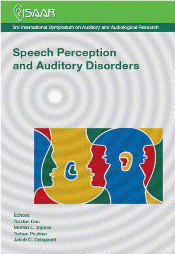Objective measurement of listening effort while using first and second language in simulated cochlear implants
Resumé
It is generally believed that the cognitive effort to understand speech under adverse listening conditions differs between first and second languages. The present study examined this issue with 10 native Kannada speakers who use English as a second language. Subjects listened to noise band vocoder (simulated Cochlear Implant in normal’s) processed sentences in quiet, noise (-6 dB SNR) and visual reaction time conditions. The listening effort was measured using a dual task paradigm. The mean scores obtained were better for Kannada than English. Repeated ANOVA measures indicated a significant main effect of listening conditions in both languages. The listening effort was larger while using English (second language). The visual reaction time data indicated a larger reaction time for English. The data in general suggests an increased cognitive effort for the processing of the second language. Speech perception under adverse listening conditions was significantly higher for the first language and demonstrates the importance of language proficiency in everyday listening conditions. The measurement of the listening effort using the dual-task paradigm has shown that it provides an additional index of speech perception under different listening conditions beyond traditional word recognition scores for each language in bilinguals.
Referencer
Choi, S., Lotto, A., Lewis, D., Hoover, B., and Stelmachowicz, P. (2008). “Attentional modulation of word recognition by children in a dual-task paradigm”. J Speech Lang Hear Res., 51, 1042–1054.
Downs, D. (1982). “Effects of hearing aid use on speech discrimination and listening effort”. J Speech Hear Dis., 47, 189–193.
Downs, D. and Crum, M. (1978). “Processing demands during auditory learning under degraded listening conditions”. J Speech Hear Res., 21, 702–714.
Edwards, B. (2007). “The future of hearing aid technology”. Trends Amplif., 11(1), 31-46.
Feuerstein, J. (1992). “Monaural versus binaural hearing: Ease of listening, word recognition and attentional effort”. Ear Hear, 13(2), 80–86.
Fraser, S., Gagné, J.-P., Alepins, M., and Dubois, P. (2010). “Evaluating the effort expended to understand speech in noise using a dual-task paradigm: The effects of providing visual speech-cues”. J Speech Lang Hear Res, 53, 18–33.
Friesen, L.M., Shannon, R.V., Baskent, D., and Wang, X. (2001). “Speech recognition in noise as a function of the number of spectral channels: Comparison of acoustic hearing and cochlear implants”. J Acoust Soc Am., 110, 1150–1163
Ganesh, A.C., Bopanna, S., and Appaiah, S. (2011). “Objective Measurement of Listening Effort In Simulated Cochlear Implants With and Without Frequency Modulation”. 43rd Indian Speech and Hearing Association Conference 2011, Kolkatta, India.
Gatehouse, S. and Noble, W. (2004). “The Speech, Spatial and Qualities of Hearing Scale (SSQ)”. Int J Audiol, 43, 85-99.
Humes, L. and Humes, L. (2004). “Factors affecting long-term hearing aid success”. Semin Hear, 25(1), 63-72.
Kahneman, D. (1973). Attention and effort. New Jersey: Prentice-Hall.
Kiessling, J., Pichora-Fuller, K., Gatehouse, S., Stephens, D., Arlinger, S., Chisolm, T., et al. (2003). “Candidature for and delivery of audiological services: special needs of older people”. Int J Audiol., 42(2), S92-S101.
Kumar, U.A., Avinash M. C. and Meti, R.R. (2010). “Development of Sentences for Quick Speech-in-Noise (QuickSin) Test in Kannada”. Journal of Indian Speech and Hearing Association., Vol 24(1), page 59-65
Kumar, U.A. and Thakur, A. (2009). “Development of sentence material for quick speech in noise test in Indian accented English”. Unpublished Master Dissertation, Mangalore University, Mangalore, India.
Marian, V., Blumenfeld, H., and Kaushanskaya, M. (2007). The Language Experience and Proficiency Questionnaire (LEAP-Q): Assessing Language Profiles in Bilinguals and Monolinguals” J Speech Lang Hear Res., 50, 4, 940- 967.
Rakerd, B., Seitz, P., and Whearty, M. (1996). “Assessing the cognitive demands of speech listening for people with hearing losses”. Ear Hear., 17, 97–106.
Rogers, C. L., Lister, J. J., Febo, D. M., Besing, J. M., and Abrams, H. B. (2006). “Effects of bilingualism, noise, and reverberation on speech perception by listeners with normal hearing,” Appl. Psycholinguist. 27, 465– 485.
Sarampalis, A., Kalluri, S., Edwards, B., and Hafer, E. (2009). “Objective measures of listening effort: Effects of background noise and noise reduction”. J Speech Lang Hear Res., 52, 1230–1240.
Yderligere filer
Publiceret
Citation/Eksport
Nummer
Sektion
Licens
Authors who publish with this journal agree to the following terms:
a. Authors retain copyright* and grant the journal right of first publication with the work simultaneously licensed under a Creative Commons Attribution License that allows others to share the work with an acknowledgement of the work's authorship and initial publication in this journal.
b. Authors are able to enter into separate, additional contractual arrangements for the non-exclusive distribution of the journal's published version of the work (e.g., post it to an institutional repository or publish it in a book), with an acknowledgement of its initial publication in this journal.
c. Authors are permitted and encouraged to post their work online (e.g., in institutional repositories or on their website) prior to and during the submission process, as it can lead to productive exchanges, as well as earlier and greater citation of published work (See The Effect of Open Access).
*From the 2017 issue onward. The Danavox Jubilee Foundation owns the copyright of all articles published in the 1969-2015 issues. However, authors are still allowed to share the work with an acknowledgement of the work's authorship and initial publication in this journal.


